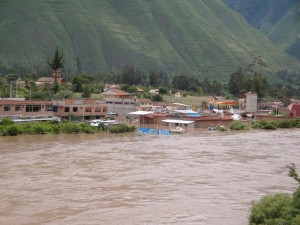I flew into Santiago airport with some trepidation – arriving just days after one of the world’s largest recorded earthquakes, at 8.8 – but it takes a while to spot any sign of damage at all. Given that most taxi drivers can never resist a moan, mine was more concerned that the 2005 Skoda he’d just acquired had been installed with a tape rather than cd player. ‘What is the point of that,’ he complained and apologised. He’d wanted to play me some Iron Maiden to celebrate my common British heritage with the group.
Heading into town, we cross a few bridge-sections of road which have had to be plated together, but Santiago itself seems unmarked. The Zócalo, the central square, is the usual picture of shoe-shine boys, old men sitting on benches and a religious nut preaching the end of the world to a disinterested audience.
In the shopping streets nearby, the atmosphere is rather as if a fire alarm had gone off in John Lewis and now everyone was back in the building and shopping. But then the Chileans are different from the rest of South America. As one tells me: ‘Everyone here is middle-class – except for the new president, Pinero, and his friends, who are filthy rich!’ Many of the more menial jobs – the maids, the cleaners, the security guards – are taken by Peruvian and Bolivian immigrants these days.
The rest of the continent make jokes about the Chileans being a nation of bland shop-keepers, from their less spicy food to the mild, more temperate climate they enjoy. I was impressed by the resilience and pragmatism they showed in the face of the earthquake – and by the foresight with which buildings had been constructed, in the main, to withstand such huge force. But then they have had a long time to get used to such attacks. 175 years ago, almost exactly, Charles Darwin witnessed the Chilean town of Concepción, then, as now damaged by a ferocious earthquake: ‘the most awful yet interesting spectacle I ever beheld.’
Eating a caldillo of conger eel in the Central Market, a magnificent iron-framed building erected by British investors in the past, I found the food was not so much bland as a balance of interesting flavours – perhaps why the Chileans have always been such natural and loyal allies of the British, from the 19th century War in the Pacific to that other 20th century War in the Atlantic, the Falklands. We too have been accused of being a nation of shopkeepers; though quite how we’d deal with a 8.8 earthquake, given our incapacity to handle a few wet leaves on a railway track, I’m not so sure.
written March 8 (posted late due to technical issues in posting from Pacific, as several of following posts will be as well!)

 The recent news that ex British Army captain Ed Stafford has completed his 859 day walk along the Amazon from its source to the sea deserves comment – and praise. It’s an epic achievement and one never achieved before. Previous attempts have always been made partly by boat, and for good reason: some areas of the Amazon, like the Solimoes in Brazil, flood for hundreds of kilometers each year and there are no roads along the main river, so to walk the entire length is daunting.
The recent news that ex British Army captain Ed Stafford has completed his 859 day walk along the Amazon from its source to the sea deserves comment – and praise. It’s an epic achievement and one never achieved before. Previous attempts have always been made partly by boat, and for good reason: some areas of the Amazon, like the Solimoes in Brazil, flood for hundreds of kilometers each year and there are no roads along the main river, so to walk the entire length is daunting.
 He was describing his recent work at a site called Huaca el Pueblo, where they uncovered a tomb dating from around 300 to 500 AD. Inside were the remains of four individuals, two men and two women, all in their twenties at the time of death. Working at frantic speed over the space of five weeks to beat the threat from both the humidity and local looters, his team of archaeologists injected alcohol under the mask of ‘the highest status individual’ – who Bourget has called ‘the Lord of Ucupe’ – to loosen it up for removal from his face in the normal way. They then used thin slivers of bamboo to lift it, only to discover another mask underneath, like a Russian doll.
He was describing his recent work at a site called Huaca el Pueblo, where they uncovered a tomb dating from around 300 to 500 AD. Inside were the remains of four individuals, two men and two women, all in their twenties at the time of death. Working at frantic speed over the space of five weeks to beat the threat from both the humidity and local looters, his team of archaeologists injected alcohol under the mask of ‘the highest status individual’ – who Bourget has called ‘the Lord of Ucupe’ – to loosen it up for removal from his face in the normal way. They then used thin slivers of bamboo to lift it, only to discover another mask underneath, like a Russian doll.